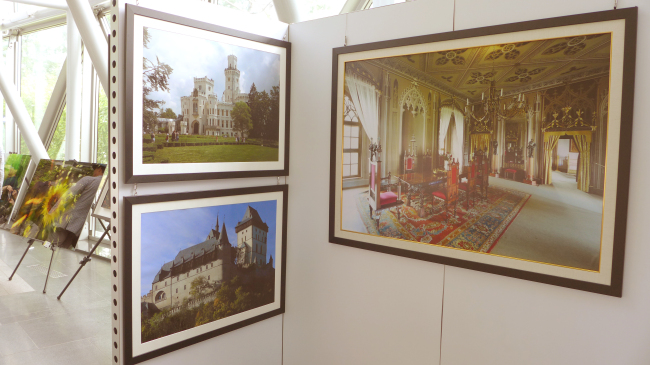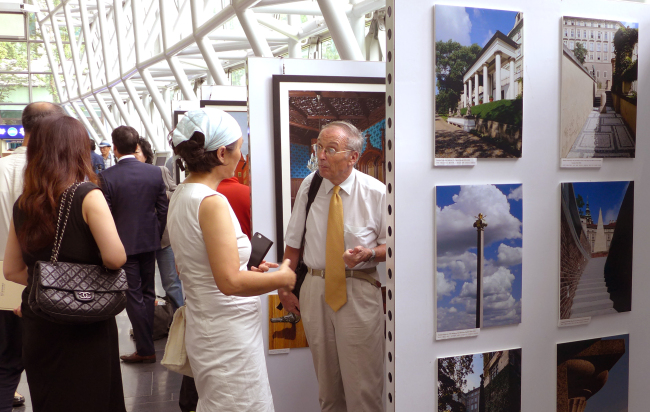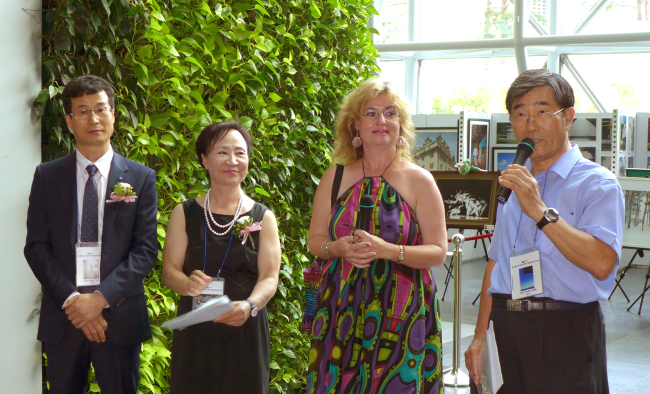Czech Republic, Korea fete silver jubilee through architecture
By Korea HeraldPublished : Aug. 23, 2015 - 21:59
Marking the 25th anniversary of ties with Korea, the Czech Embassy held a photo exhibition last week at Seoul City Hall that showcased the country’s traditional architecture.
“The Architecture of Prague Castle” featured photographs by Damjan Prelovsek, a photographer, art historian and former Slovenian ambassador to the Czech Republic from 1998 to 2002. The two-day exhibition displayed pictures of palaces and chateaux from across the country.
Prague Castle is regarded the most significant monument and cultural institution in the Czech Republic, as it was the seat of Bohemian kings, Holy Roman emperors and Czech presidents before becoming a presidential residence.
The largest ancient castle in the world, the edifice was constructed in 870 and renovated by Slovenian architect Joze Plecnik in the 1920s and 30s. Timeworn furniture, artworks and decorations adorn the interior, while grandiose facades and patterned gardens foster a “romantic” ambiance for photography and filming.
“The Architecture of Prague Castle” featured photographs by Damjan Prelovsek, a photographer, art historian and former Slovenian ambassador to the Czech Republic from 1998 to 2002. The two-day exhibition displayed pictures of palaces and chateaux from across the country.
Prague Castle is regarded the most significant monument and cultural institution in the Czech Republic, as it was the seat of Bohemian kings, Holy Roman emperors and Czech presidents before becoming a presidential residence.
The largest ancient castle in the world, the edifice was constructed in 870 and renovated by Slovenian architect Joze Plecnik in the 1920s and 30s. Timeworn furniture, artworks and decorations adorn the interior, while grandiose facades and patterned gardens foster a “romantic” ambiance for photography and filming.

“Czech buildings have always been at the forefront of European architecture by embodying different styles ― Medieval, Gothic, Renaissance, Baroque and contemporary,” said Prelovsek, who extensively studied the work of Plecnik, in an interview with The Korea Herald on Tuesday. “Czech families travel around the country on weekends to learn about the histories and architectures of castles.”
Czech culture has been open to diverse civilizations and people crisscrossing across Europe, which led to intercultural contacts, explained Prelovsek. Czech architecture was influenced by Western and Eastern Europe before communist times, he added.
The Iron Curtain prevented much contact with the outside world for over four decades, but following its fall, the Czech culture and economy have opened up to embrace European and global influences, Prelovsek said. Czech students who studied abroad brought home new ideas and styles, enriching the national treasury.
During communist times, socialist housing schemes created monotonous, drab flats, which have undergone reconstruction and reparation to this day. Ideological statues were either destroyed or preserved in museums as tourism artifacts, he said, adding that streets named after revolutionaries were rechristened.

In commemoration of the silver jubilee, Prelovsek and Czech Embassy Charge d’Affaires Jana Chaloupkova are preparing to publish a book this year on the architecture, landscape and culture of the two countries, combining photographs and descriptions.
Chaloupkova noted that the Czech Republic and the Republic of Korea have made great strides in political, economic and cultural domains over the last 25 years. Korea Foreign Minister Yun Byung-se visited Prague in mid-July last year, and Czech Prime Minister Bohuslav Sobotka visited Seoul in February, with the two sides forging a strategic partnership.
About 175,000 Koreans visited the Czech Republic last year, mainly Prague, dubbed the “Paris of Eastern Europe,” but many destinations remain unexplored, Chaloupkova said.
“Visitors can take beautiful photos, particularly for weddings, in front of romantic castles and elegant gardens,” the diplomat recommended. “Festivals, exhibitions, operas and concerts of Europe’s finest quality are available day and night.”

In Prague, three big opera houses ― the National Theatre, Tyl’s Theatre and the State Opera ― host performances within their gold-encrusted interiors.
Art education has been well-sponsored across different institutions, such as Charles University ― Central Europe’s first university, founded in 1348, where Korean studies has been offered since 1949. The Czech Ministry of Culture offers grants to artists, many of them young, and supports the translation of Czech literature abroad.
Eight direct flights are available each week between Prague and Incheon, operated by Czech Airlines and Korean Air. The CzechTourism Seoul Office opened in 2013, along with the Czech Center Seoul, which promotes Czech culture around the world.
The exhibition was a collaboration between Korea Image Broadcasting Corporation, Korea Culture Association and the Seoul Metropolitan Government.
By Joel Lee (joel@heraldcorp.com)
-
Articles by Korea Herald








![[KH Explains] Hyundai's full hybrid edge to pay off amid slow transition to pure EVs](http://res.heraldm.com/phpwas/restmb_idxmake.php?idx=644&simg=/content/image/2024/04/18/20240418050645_0.jpg&u=20240419100350)







![[From the Scene] Monks, Buddhists hail return of remains of Buddhas](http://res.heraldm.com/phpwas/restmb_idxmake.php?idx=652&simg=/content/image/2024/04/19/20240419050617_0.jpg&u=20240419175937)

![[KH Explains] Hyundai's full hybrid edge to pay off amid slow transition to pure EVs](http://res.heraldm.com/phpwas/restmb_idxmake.php?idx=652&simg=/content/image/2024/04/18/20240418050645_0.jpg&u=20240419100350)

![[Today’s K-pop] Illit drops debut single remix](http://res.heraldm.com/phpwas/restmb_idxmake.php?idx=642&simg=/content/image/2024/04/19/20240419050612_0.jpg&u=)